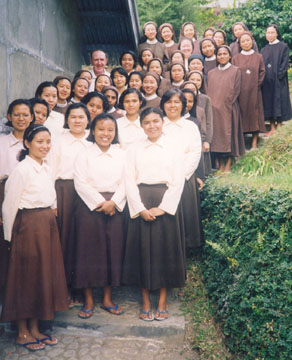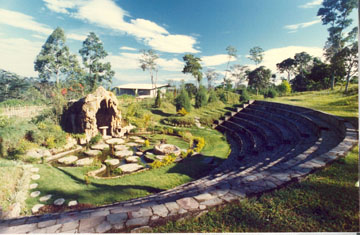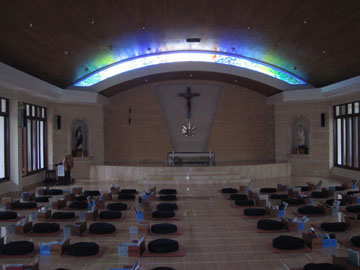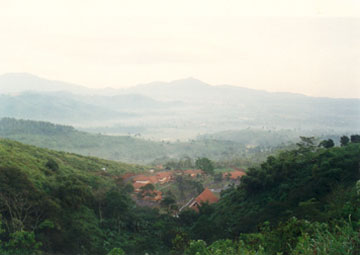 Córki Karmelu (Putri Karmel) i Karmelici Św. Eliasza (Carmelitae Sancti Eliae) są dwoma oddzielnymi instytutami życia konsekrowanego założonymi przez karmelitę P. Yohanes Indrakusama O.Carm en 1982 (siostry) i w 1986 (bracia) w diecezji Malang, Indonesia. W 2002 zostali afiliowani do Zakonu Karmelitów Dawnej Obserwancji.
Córki Karmelu (Putri Karmel) i Karmelici Św. Eliasza (Carmelitae Sancti Eliae) są dwoma oddzielnymi instytutami życia konsekrowanego założonymi przez karmelitę P. Yohanes Indrakusama O.Carm en 1982 (siostry) i w 1986 (bracia) w diecezji Malang, Indonesia. W 2002 zostali afiliowani do Zakonu Karmelitów Dawnej Obserwancji. Zakonnicy obu zgromadzeń poświęcają zupełnie swoje życie Królestwu Bożemu, by być w tym świecie świadkami wartości duchowych transcendentalnych.
Inspirują się dziedzictwem duchowym Karmeli, w sposób szczególny dzielami Teresy od Jezusa, Jana od Krzyża i Teresy od Dzieciatka Jezusa i Najświętszego Oblicza.m którzy przeżyli życie dając śwadectwo radykalnego zhednoczenia z Bogiem. Bracia i siostry nawiązują do Karmelu pierwotnego i instytucji Eremu Karmelitańskiego. Posiadaja domy pustelnicze, które bezpośrdeni inspirują się ideąTomasza od Jezusa. Niektórzy zakonnicy wezwani sa do apostolatu i bezpośredniej ewangelizacji.Niektórzy żyją życiem ściśle kontemplacyjnym w zupełnej samotności. W ich pustelnich zawsze jest miejsce dla braci i sióstr życia apostolskiego, ktorzy mogą w nich spędzić dowolny okres czasu.Zresztą konstytucje wspólnoty podkreslają, że apostolat nigdy nie powinien byc przyczyną zaniedbania zycia kontemplacyjnego i z tego powodu nakazują okresowy i regularny powrót do domów pustelniczych. Ze swojego apostolatu wyłączają szpitele, parafie i szkoły. Pierwszym i najdonioslejszym apostolatem jest świadectwo życia rozmiłowanego w Bogu i życia zupełnie Mu konsekrowanego. Z tego wypływa pragnienie by inni poznali Boga. Stąd propozycja kierownictwa duchowego, posługi sakramentem pojednania, szkoły modlitwy, rekolekcje w milczeniu, sesje nt, duchowości i dzieł Mistrzów Karmelu oraz obozy letnie dla młodych. Wiekszość apostolatów odbywa się wewnątrz ich klasztorów. Co więcej stanowią oni bardzo dobry przykład inkulturacji życia konsekrowanego do warunków azjatyckich, wykorzystując elementy duchowości rodzimej, gdy są kompatybilne z chrześcijaństwem. Mocnym akcentem jest duchowość charyzmatyczna i obecność charyzmatów i modlitwy typu odnowowego w codziennym życiu wspólnot i posłudze apostolskiej.
Wsólnota Braci liczy ponad 70 członków i jest obecna w Indonezji. Wspólnota sióstr jest prawie dwukrotnie liczniejsz i posiada już domy w Rzymie i Stanach ZJednoczonych oprócz domów w rodzimej Indonezji.
Wywiad z założycielem (po angilesku):
Interview with Fr. Yohanes Indrakusuma, O. Carm.
How did you become the founder of two religious groups?
I had no intention to be the founder of anything. I knew I was called to a more contemplative way of life as a Carmelite. As a student I thought I could only go to Wolfnitz (Wolfnitz was an international Carmelite community located in Austria whose members followed an eremitical lifestyle). I was ordained in 1967 and in 1968 I was sent for further studies to Rome. I stayed at San Alberto for one year for my licence in theology at the Gregorian (at that time it was still possible to take a licence in one year by passing an exam). I had hoped to be able to go to Wolfnitz during my stay in Europe, but when I came in 1968 it was closed. When I was in France (July 1969-April 1973) the desire for a more quiet, contemplative way of our life stayed with me and became even stronger.
I returned to Indonesia and taught dogmatic theology and spirituality at the seminary in Malang. The solitary life became more and more attractive. I finally asked the provincial for permission and in 1975, the provincial and the council gave permission. However, I had to continue teaching at the seminary. So two days a week I would teach theology and the rest of the time I lived as a solitary. However, there was a reaction against this. As a compromise we started in Ngroto, near Batu. I remained alone until 1982.
The first place was on a main road. This place is quite remote so I thought people would not come easily but in fact, more people came.
How did the idea of establishing a female congregation, the Putri Karmel, come about?
At the beginning when visiting Ngroto, a Carmelite priest, Brocardus Jayus, suggested that this way of life be open to women, but I did not react. Then there was a sister from the Congregation of the Divine Providence who would come to visit along with other young women. They were attracted to this way of life. Eventually she received the permission of her superior to explore the life further. The sister was very persistent and eventually came to stay along with another sister and three other young women (including the current Superior General of Putri Karmel, Sr. Justini Kesuma). We started. After three months, one left, and the original sister too left but others came. The Congregation was officially opened by the Indonesian Provincial in 1982.
It must be difficult to be a hermit with all this activity happening around you?
Another turn in my life was that I wanted to live alone and all these people were interrupting my solitude. So one day when I was complaining to the Lord, I heard Him say in my heart: "Yohanes, which is more important, your desires or my will?".
Before that moment it was always difficult because the people were always disturbing my solitude. From then I received people in peace. Now there are 109 sisters in the Congregation.
 How did the men’s congregation, the Carmelites of Saint Elijah, get its start?
How did the men’s congregation, the Carmelites of Saint Elijah, get its start? In 1985, the men’s group started with three young men. At the time we did not know how to deal with them. Realistically they should be incorporated into the Order but the Chapter said that everyone had to go to a common novitiate. Incorporating them into the Province would have been very difficult and we couldn’t be under the Prior General.
After discernment with the young people, we decided to make a separate public association. This happened in 1986. We are now in the process of becoming a diocesan congregation. Right now there are 63 men in the congregation.
What background do the members have?
It is interesting that among the brothers and sisters, but especially the sisters, most have university degrees and some work experience. They tend to come from the cities and not from the villages. The formation for the sisters was initially done with the assistance of a Franciscan novice mistress. She stayed for two years in order to get a solid program of formation in place.
What is the life like in these two congregations?
There are two styles of life within both the male and female groups. A number of the members are hermits. A second group makes up the base communities. They are contemplative but with some ministry. They may do counseling, give retreats, seminars, or offer prayers for individuals.
They are also involved in some traveling since we are beginning to bring the ministry to other places. In the last nine years, the Indonesians living abroad have invited the brothers and sisters to come and do retreats and workshops in the countries where they now live.
 How are the two congregations structured?
How are the two congregations structured?Well, the sisters have their own superiors. My role is really to be supportive. We occasionally have a meeting. They may get me more involved in certain issues, among other things in financial matters.
The brothers have their own local superiors. I still function as their major superior. However, only one from the original group of brothers stayed with us. Unfortunately he got sick and died quite young. It has not been as stable a start as the sisters had.
After six years, I was compelled to leave the sisters to themselves, but they grow well and steadily until today. We have experienced some difficulties because we were doing something quite new.
What is the future?
For the sisters, the future is fairly clear. The men’s future is still not so clear. However, judging from the existing brothers, there is hope for the future. We will work mostly in formation of lay cadres or leaders, but also for the religious as well.
The spiritual formation for priests is badly needed in Indonesia and we are discerning if the Lord calls us in that direction. We have started with the formation of lay leaders among our lay community and I envisage to broaden the scope of this formation to comprise other lay leaders as well. But I hesitate to say exactly what the future will bring because the Lord always seems to have surprises for me!
There are two other priests with me right now, but none of the CSE yet. During these years the Lord sent priests to help me in the center and in the formation. Lord willing, we will have an ordination this year (2006) and the following years. That would be an ordination for the diocese. Once we are a diocesan congregation, we could have priests ordained for the Congregation.
 Certainly the world needs quiet, solitude, the time to reflect.
Certainly the world needs quiet, solitude, the time to reflect.We have a beautiful site —mountains, forest—and we need to share that with priests. We want to share our lives not only with Carmlites but also with other priests. That could just be my dream though.
The sisters are now being invited to give retreats to other congregations. This is quite a change. In the beginning our sisters were looked down upon by the clergy and the other congregations of sisters. That has changed.
I was being asked to give retreats but it became too much for me. So once I offered to send "my assistants" –I did not dare say "the sisters can come"— who are well trained in the field of spirituality. The sisters went and were quite successful. That ended the negative prejudice. Sometimes you have to resort to this way of marketing you know!
Now the brothers and sisters have to limit the work. We just cannot respond favorably to all the requests. For that reason, God willing, we plan to have a spiritual formation course for formators – a live in course for two months. We hope to bring these people to a real experience of God and to deepen their religious experience. The course will be based on the teachings of Carmelite saints and the spirituality of the Charismatic Renewal, such as inner healing or healing of memories, the gifts of the Spirit, and so on.
How much is charismatic renewal involved in what you do?
I would have to say that my ministry is inconceivable without the charismatic experience. To level the ground of a hilly site for a building, you can use shovels. But it will take a long time. We use a bulldozer, the Charismatic Renewal. It is quicker and we can build more easily. To build the building itself we do not use a bulldozer but more subtle tools like, as I mentioned before, Carmelite spirituality. Our members draw their inspiration from the spiritual heritage of Carmel as perpetuated in history by the great saints of the Order.
 How has the charismatic renewal affected your life?
How has the charismatic renewal affected your life? Reflecting on almost 30 years of doing this, I am glad I came to know the charismatic renewal through theology rather than the rough experience. After my experience with people, I can clearly distinguish between the theological aspects of renewal and its sociological expression. The theological context is that we need the power of the Holy Spirit to live as a Christian. The theological contents of the experience of the outpouring of the Holy Spirit is an experience of the living God and to have a real encounter with the living Jesus. This is the great gift of the renewal to the Church. Why should we Carmelites be deprived of it?
To be able to preach with conviction you need the gifts of the Holy Spirit and dependence upon the Holy Spirit. The gifts are not the ends but the means. For example, I am grateful that I knew John of the Cross before I knew the Charismatic Renewal. But this presence of the Holy Spirit is necessary for every Christian—regardless of their particular vocation.
The sociological aspect is that exterior expression. People express it in different ways – most often according to their culture. Unfortunately, many people do not distinguish between the two aspects and this has caused great problems within the movement.
There is also a lay community?
Our lay group, the Holy Trinity Community, is made up of 541 "cells" with 5651 members, young and old. The minimum number of members for a cell is four and the maximum is 16. Then they have to split like a living organism continues to split.
It original members took part in a retreat which was a powerful experience for many. They experienced renewal and conversion in their lives. Jesus became a real, living person for them. Many continued this experience by spending more than one hour each day in prayer and Scriptural reading.

















Brak komentarzy:
Prześlij komentarz